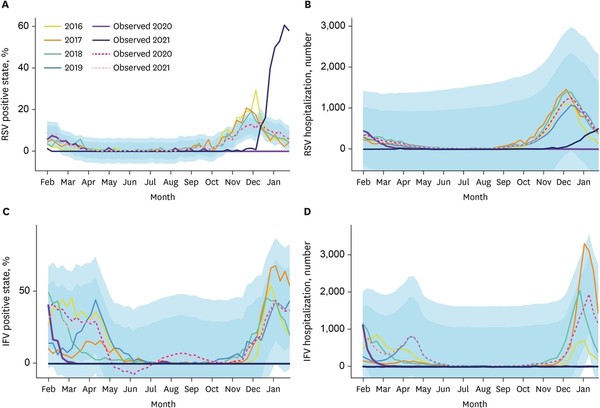Respiratory syncytial virus (RSV) infections increased after Korea started to ease social distancing rules such as mandatory mask-wearing, a study showed.
A research team at Yonsei University College of Medicine published their study, titled “Respiratory Syncytial Virus Outbreak Without Influenza in the Second Year of the Coronavirus Disease 2019 Pandemic: A National Sentinel Surveillance in Korea, 2021–2022 Season,” in the Journal of Korean Medical Science (JKMS).
RSV is transmitted through an infected person’s secretions, direct contact, or respiratory droplets. It can cause pneumonia in the elderly or immunocompromised. RSV infections, along with influenza virus (IFV) infections, are usually prevalent in autumn or winter.
In the initial stage of the Covid-19 pandemic in early 2020, enhanced public health measures or nonpharmacological interventions (NPIs), such as mandatory mask-wearing, isolation of Covid-19 patients, and strict social distancing greatly reduced respiratory infections other than Covid-19 drastically.
However, the research team said that the government alleviated the intensity of NPIs from January 2022, leading to an uptick in RSV infections.
The research team collected clinical data of inpatients with acute respiratory illness from 192 medical institutions and data from outpatients from 52 institutions, using the Korean Influenza and Respiratory Virus Monitoring System (KINRESS) database.
They collected 407,550 samples from inpatients and 58,682 samples from outpatients.
The research team defined the period from January 2016 to January 2020 as the pre-NPI period and from February 2020 to January 2022 as the NPI period.

According to the analysis, RSV infections started to rise in late November 2021, and the weekly positivity rate marked 61 percent in the third week of January 2022.
The average weekly positivity rate of RSV from February 2021 to January 2022 was 5.7 percent, 1.5 times higher than that of the pre-NPI period.
The rate of hospitalization for RSV infection was 16.7 percent in the pre-NPI period, about 35-48 percent higher than that between February 2020 and January 2021.
In contrast, the weekly positivity rates and hospitalization for IFV infections were significantly lower in the NPI period than in the pre-NPI period.
There were no positive cases among 4,902 samples analyzed between February 2021 and January 2022, and the hospitalization rate was only 1.3 percent in the period before NPIs.
“So far, the RSV infection rate has been half of that in the pre-NPI period. However, the resurgence of FSV infections is possible as the domestic NPIs are eased,” the research team said.
The research team went on to say that it was necessary to continuously monitor the scale of endemic transmission of RSV when the NPIs are relaxed further or lifted completely in the future.
The research team added that it could be helpful when setting priorities for prevention and proper quarantine.

